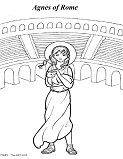 |
Agnes
of Rome Agnes was born over one-thousand and seven-hundred years ago, in the year 291 AD. Her parents were rich, and they were among the early Christian families. Agnes was barely old enough to be considered for marriage. Many men wanted to marry her. She told all the men "no." She said that she would never marry, that she would devote her life to Jesus. Men whom she refused to marry reported Agnes to the government authorities for being a Christian. In that time and place, it was illegal to be a Christian. Agnes was sentenced to death for being a Christian. |
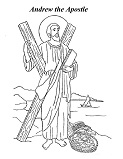 |
Andrew
the Apostle Andrew was a fisherman. He became a disciple of St. John the Baptist. That means that Andrew was listening to the teachings of St. John the Baptist. Then, after Andrew meet Jesus, Andrew told his brother Simon Peter, "We have found the Messiah." Because Andrew was the first to see Jesus as the Messiah, St. Andrew is called the "First-Called." He converted many people to be followers of Jesus Christ. Because of that, Andrew was arrested and crucified head downward on a cross that was in the shape of an "X." Saint Andrew often is shown in art with fish -- because he was a fisherman -- and with a cross in the shape of an “X.” |
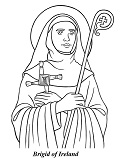 |
Brigid
of Ireland Brigid was born over one-thousand and five-hundred years ago, in the year 451. She was Irish, and she was born into slavery in Ireland. Her mother was a slave; her father was a chieftain. When her mother was pregnant with Brigid, Brigid’s father sold her mother. When Brigid was 10 years old, Brigid was returned to her father. She would feed the poor by giving away her father’s possessions. That angered her father, and he tried to sell Brigid to a king. The king was a Christian and saw that Brigid had a good heart. The king convinced Brigid’s father to give her her freedom. Brigid took over running her father’s dairy farm. The dairy farm made her father lots of money even though she gave milk to the poor. Brigid founded monasteries. She founded a school of art. She produced an art book that was called a “work of angelic and not human skill. Unfortunately, that art book has been lost to history, and we no longer know how good it was. |
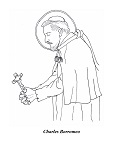 |
Charles
Borromeo Charles was born just over 500 years ago, in 1538. He was a man of great integrity and modesty. His family gave him a huge amount of money, but he kept only enough month to pay for his education and to prepare for a life of service to the Church. He said that the rest of the money belonged to the poor, and he gave it to them. Charles had a speech impediment. Because it was hard for him to say some words, some people thought Charles was dumb. But the truth was that Charles was brilliant. He earned a doctorate degree in cannon and civil law. He became a priest and then the Archbishop of Milan. The diocese of Milan was the largest diocese in the Catholic Church. Unfortunately, it also was filled with corruption and dishonesty. Charles worked at ending the corruption. He stopped taking money from people who wanted to commit sins but pretend that they had not sinned. He founded schools, seminaries, and colleges for people to be educated to become priests. When he was Archbishop of Milan, there was a famine and the plague. Many people were starving. He used his own money to feed the starving people. When he had used all of his own money, he borrowed money and went deeply into debt. He fed 70,000 people each day. Charles is credited with founding the Confraternity of Christian Doctrine (CCD), consisting mainly of lay people to provide religious education for children. |
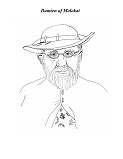 |
Damien
of Molokai Damien was born almost 200 years ago, in 1840, in a country called Belgium. He grew up on a farm. He moved to Hawaii where he became a priest. He worked with very sick people whom other people did not want to help. The sick people had a disease called "leprosy," and they were forced to live by themselves on the island of Molokai. Damien offered spiritual and medical care and encouraged them to live in moral ways. He led them to build houses, schools, and a church. He spent many years working with the people on the island. Eventually, he got leprosy himself, but he continued working for the people. Damien said, "My greatest pleasure is to serve the Lord in his poor children rejected by other people." |
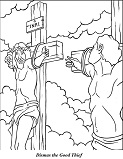 |
Dismas
the Good Thief Dismas was with Jesus when Jesus died on the Cross. All that is known about Dismas is that he was the Good Thief who was crucified with Jesus on Calvary Hill. We use the name "Dismas" for him, but we do not really know what his name was. Dismas was one of two criminals who were nailed to crosses to die, next to where Jesus was nailed to a cross to die. While the three men were hanging on crosses, waiting to die, Dismas said to the other criminal, "We have been condemned justly, but this man has done nothing criminal." And Dismas said to Jesus, "Remember me when you come into your kingdom." Jesus replied, "Today you will be with me in Paradise." Dismas asked Jesus for forgiveness. Jesus forgave Dismas. God will always forgive you if you are sorry and ask for forgiveness. |
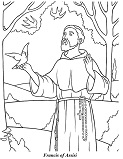 |
Francis
of Assisi Francis was born about nine-hundred and forty years ago, in 1181. He was born into a wealthy family. When he was about 25 years old, he believed he heard a message from God telling him to repair the church. Francis assumed that meant to repair the church building that he was then standing inside. So he rebuilt that church. Then, he finally understood that he should work to rebuild the whole of the Catholic Church. Francis began preaching and began going directly to any priest who was doing bad things. Francis chose to live in poverty and would preach to anyone — even animals and birds. Francis was a deacon, but never a priest. He tried to imitate Jesus and carry out Jesus’ work. |
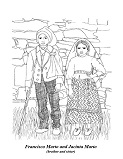 |
Francisco
and Jacinta Marto (brother and sister) Francisco and his little sister Jacinta were young children who were shepherding a flock of sheep when the Virgin Mary appeared to them and their cousin Lucy. They lived a little more than one hundred years ago in a country called Portugal, near a place called Fatima. They died when they were still children. Francisco was born in 1908 and died when he was 11 years old. His sister Jacinta was born in 1910 and died when she was 10 years old. The children saw visons of the Blessed Virgin Mary in 1917, one-hundred and four years ago. The appearances of the Virgin Mary in 1917 are called "Our Lady of Fatima." Mary asked the children to pray to ask God to help the world. |
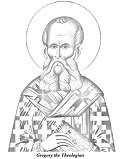 |
Gregory
the Theologian Gregory was the son of Saint Gregory the Elder and Saint Nonna. He was born in about 325 AD. He is one of four saints who are called "Theologian." He had a special gift for finding the best words. He helped to write the Nicene Creed. He wrote the description of God as Father, Son, and Holy Spirit. His words help to explain how the Father, the Son, and the Holy Spirit relate to each other. The Nicene Creed is the part of Mass that begins, "I believe in one God, the Father almighty, maker of heaven and earth, of all things visible and invisible." We say the Nicene Creed every Sunday at Mass. |
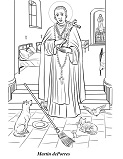 |
Martin
dePorres Martin dePorres was born in 1579 in Lima, Peru, in South America. His father was a Spanish man. His mother was a freed slave whose ancestors were African or Native American. His parents were not married. When Martin was just a little boy, his father abandoned him. Martin grew up in poverty. He often was made fun of and picked on because of the color of his skin. He wanted to become a priest, but in Peru the law said that he was not allowed to become a priest because of the color of his skin. He begged some Dominican brothers to accept him as a volunteer and to allow him to do the most menial tasks in the monastery, if, in return, he would be allowed to wear the habit and live with the religious community. He lived in the monastery and took care of the brothers. He cooked; he cleaned; he cared for the sick. He did this without complaining. He came to be known as "the saint of the broom" because of the menial work he did. He served everyone as a way to serve God. Eventually, Martin was allowed to become a Dominican lay brother. He worked in the infirmary, where he took care of sick people. He took care of all people, no matter what the color of their skin, and no matter whether they were rich or poor, and no matter whether they were nobles or slaves. Once he was disciplined for not following some rules and for, instead, taking care of some sick people. Martin said, "Forgive my error, and please instruct me, for I did not know that the precept of obedience took precedence over that of charity." |
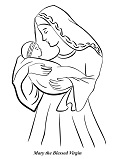 |
Mary,
the Blessed Mother Mary is Jesus' mother. She also is known as "the Blessed Virgin," and "the Holy Mother of God," and and "Queen of Heaven," and "the Blessed Mother," and "Our Lady." Mary was the daughter of Joachim and Anne. Mary was born in Jerusalem. She was Jewish and grew up among Jewish people. When she was not much more than a young girl and living in Nazareth, Mary was visited by the archangel Gabriel who told her, "Greetings, favored one. The Lord is with you. Do not be afraid, for you have found favor with God. You will conceive and bear a son, and you will name him Jesus. He will be great and will be called the Son of God. And his kingdom will have no end." And Mary said, "Here I am, the servant of the Lord. Let it be with me according to the Lord." She became betrothed to Joseph. While Mary was pregnant with Jesus, Joseph and Mary had to travel to Bethlehem because of a census. Bethlehem was Joseph's city. While in Bethlehem, Mary gave birth to Jesus. Because there was no room in the inn, Mary gave birth in a place where the animals were kept. |
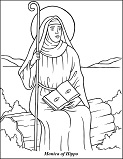 |
Monica
of Hippo Monica was born in 331 AD, in a place that is now the country of Algeria, in north Africa. When she was young, she married a man with a mean temper. His name was Patricius. His mother lived with them, and his mother also had a mean temper. Patricius was not a Christian, and he did not like Monica's praying and trying to do good Christian deeds. Monica and Patricius had three children, and he would not allow the children to be baptized. Monica kept praying for Patricius and his mother. Finally, a year before Patricius died, Monica converted her husband and his mother to be Christians. Two of Monica's three children did well, but her son Augustine was lazy and rude. When Augustine was 17 years old, Monica sent him away to school. While at school, he began following a religion called "Manichaean." When Augustine returned to his mother's home, he told his mother of his new religion. Monica was sad that he had not become a Christian, and she told him to leave. After some time, Monica made up with her son. Monica followed her son around for 17 years as he lived a wild life of parties and drinking. For 17 years, Monica prayed that he would turn his life around and become a Christian. Finally, Augustine converted to Christianity. Her son was Saint Augustine, one of the greatest saints who ever lived. |
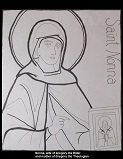 |
Nonna Saint Nonna was born in about 305 AD, in a place now known as the country of Turkey. She was the wife of Saint Gregory the Elder. They were the parents of Saint Gregory the Theologian. Saint Gregory the Elder is also known as Saint Gregory of Nazianzus the Elder. Nonna was the daughter of Christians and was raised as a Christian. When she married Gregory, he was not a Christian. She prayed to God day and night for her husband to become a Christian. Finally, her husband had a vision while he slept, and he converted to being a Christian. Her husband devoted himself entirely to the Church. He became the Bishop of Nazianzus. All three of Nonna and Gregory's children became saints. |
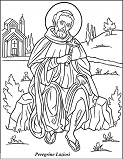 |
Peregrine
Laziosi Peregrine Laziosi was born in 1260, in Italy. He grew up in a wealthy family, and he disliked Catholics. He led people in protests against the Pope. In one protest that Peregrine led, the pope sent a religious man to try to calm down the protest. Peregrine hit the religious man in the face. The man turned his face and offered his other cheek. Peregrine was so stunned by the man offering his other cheek rather than hitting back that Peregrine repented and converted to Catholicism. Eventually, he became a priest. He was known for giving good sermons and for being a good confessor. Years later, he got sick and was diagnosed with cancer in his leg. The doctors decided that Peregrine's leg had to be amputated. Peregrine spent the night before the surgery praying all night long. He put his faith in God. The following morning, the doctors saw that Peregrine's leg was completely cured. |
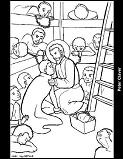 |
Peter
Claver Peter Claver was born in 1580, in the country of Spain. He was born into a very poor family. He decided to study to become a priest when he was a young man. He wrote, "I must dedicate myself to the service of God until death, on the understanding that I am like a slave." Six years after he began working to be a priest, he arrived in what is now the South American country of Columbia. He arrived in a city called Cartagena. It was the biggest slave market in the western hemisphere. Every month one thousand enslaved people arrived in Cartagena. Peter Claver dedicated himself to the service of those enslaved people. When the slave ships would arrive, Peter would go onto the ships and give food to the people. He would give them medicine, tend to the sick and dying, administer Sacraments, tell them about God, and offer to baptize them. He spent 33 years in Cartagena, serving the thousands of slaves who arrived month after month. He did not lose sight of his converts when they left the slave ships; he would follow them to plantations where they were sent and would encourage them to live as Christians, and he would beg the people holding them as slaves to treat the people humanely. Peter also fought for the slave trade to be abolished. |
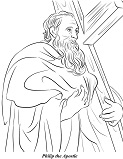 |
Philip
the Apostle Philip the was one of Jesus' twelve Apostles. He was born in what today is the country of Israel. After the resurrection of Jesus, Philip went to the country of Greece to preach Jesus' message. Philip went with his sister and with the apostle Bartholomew. They converted many people to Christianity. Among those converted was the wife of a powerful man. That made the powerful man angry, and he had Philip and his sister and Bartholomew tortured. Philip died from the torture. |
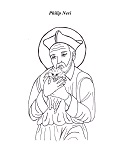 |
Philip
Niri Philip Neri was born in 1515 in Italy. As a young man, he moved to the city of Rome. He studied theology and philosophy at a monastery and was a good scholar, but he gave up any wish to be ordained as a priest. At that time, the Church was losing many believers. Philip went out onto the streets of Rome and helped poor people. He would begin conversations with strangers by asking them if they wanted to do good. Some people would ignore him. Other people would listen to his humor and conversation and do some good thing that Philip encouraged them to do. He taught people about the beauty and truth of the Catholic religion, and many returned to the church. He would do funny things to get people to listen to God's word. Philip loved to laugh. He loved to tell jokes. He knew that God's plan for us is to be happy and to live in peace with others. He loved to share the Gospel and help people to find or rediscover their faith in God. When he was 34 years old, Philip finally was ordained as a priest. Philip's joyous nature helped to bring many people back to the Church. |
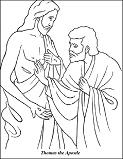 |
Thomas
the Apostle Thomas was one of Jesus' Apostles. He is known as "doubting Thomas." He was the last of the 12 Apostles to believe that Jesus had risen from the dead. Thomas doubted. Jesus showed his wounds to Thomas. Thomas saw the holes in Jesus' hands from where the nails had held Jesus on the cross, and Thomas saw the whole in Jesus' side where a soldier had thrust his spear into Jesus as Jesus was nailed on the cross. Thomas put his fingers into the nail holes in Jesus' hand, and Thomas put his hand into the opening in the side of Jesus' body. Thomas then understood that Jesus was God. After that, Thomas traveled beyond Italy and preached the Gospel as far away as India. |
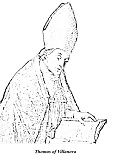 |
Thomas
of Villanova Thomas was born over 500 years ago in Spain, in 1488. He became a professor at a university and taught art, logic, and philosophy. He was ordained a priest and then became an archbishop. He sent priests across the Atlantic Ocean to Mexico hundreds of years ago (in 1533). He organized a special college for people who converted to Christianity. He lived a simple life and gave all that he could to poor people. He not only gave food and money to poor people, he helped them to find work so that they would no longer be poor, so that they would be able to take care of themselves on their own. He wrote, "Charity is not just about giving, but also about removing the need of those who receive charity and liberating them from needing charity when possible." |
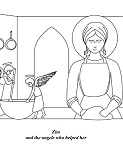 |
Zita Zita was a servant. She was born over 800 years ago in a village in Italy (in about 1212 AD). Her family was poor. When Zita was about 12 years old, she moved eight miles away from her parents and began working as a servant in the home of a rich family. Zita gave one-third of her wages to her poor parents, kept one-third for herself, and gave the rest to the poor. Before her work every day, she would go to the nearby church to pray. One day she was so absorbed in her prayer that she stayed too long and had to hurry back to begin her work of making the bread. She feared that the woman of the house might be angry at her. Zita ran to the oven, looked inside, and found that angels had made the bread while she was praying. She lived every day as a prayer to God and taught people that, whatever we do, we can do it in praise of Jesus. |